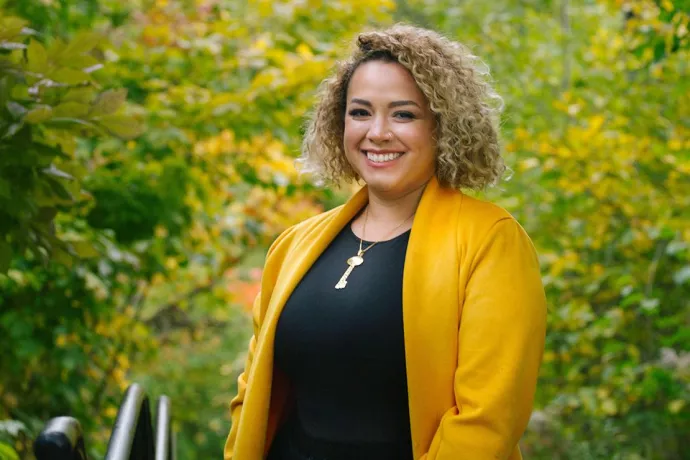
UTM graduate long-listed for Walrus journalism prize
Race and racism have dominated news cycles over the last several months, but Pacinthe Mattar (HBA, 2008) would like us to understand the stories behind the headlines—of the challenges that often face the racialized journalists who tell these and other stories.
It’s a subject she addresses in “Objectivity is a Privilege Afforded to White Journalists,” a feature article she wrote for The Walrus that published in August. It was recently longlisted for the $10,000 Allan Slaight Prize for Journalism, which is awarded annually to an independent journalist for their Walrus reporting on an important contemporary topic.
Over more than 5,000 words, Mattar makes a thoughtful and impassioned argument for diversifying media organizations by sharing her personal experiences in the field. She starts by taking us to the restless streets of Baltimore in 2015, where protesters raged at the killing of 25-year-old Black man Freddy Gray at the hands of police. Mattar was there as a producer for CBC Radio’s The Current, and among those she interviewed were two Black male participants, who described being mistreated by police. Her executive producer questioned the thoroughness of her reporting and, seemingly, the truthfulness of the men’s claims.
The experience was jarring. It was the first time Mattar had encountered what she came to understand is a deep crisis of credibility in Canadian media, one in which the objectivity of journalists of colour are unfairly called into question. As she writes in the article:
“There is the lack of trust toward the Black, Indigenous, and other racialized people whose stories we are supposed to cover as a reflection of the world we live in. Then there is the mistrust of the Black, Indigenous, and other racialized journalists who try to report on those stories. Our professionalism is questioned when we report on the communities we’re from, and the spectre of advocacy follows us in a way that it does not follow many of our white colleagues.”
This wasn’t the kind of reporting Mattar had in mind when she first started out in journalism more than a decade ago. She saw the occupation as the best way to combine her interests in writing, exploring the world, and using her different languages—born in Egypt and having lived in Dubai, Saudi Arabia and Canada, she speaks English, French and Arabic.
One year after completing her BA in political science at UTM in 2008, and one year before graduating from Ryerson University’s Master of Journalism program in 2010, she began her career as an associate producer for CBC News Network. Within two years, she switched to the more “intimate” medium of CBC radio, where she helped produce the shows As It Happens and The Current. While her broadcast career developed, she also wrote freelance stories for publications such as Toronto Life, Canadian Living and BuzzFeed News.
Over the years, she has reported on a range of issues from the devastating 2013 floods in Alberta, to Canada’s medical device implant market, to the federal government’s former ban on wearing a niqab during a citizenship ceremony. In 2011, there was the thrill of covering the Arab Spring in Egypt, and being the on-air translator for one of the country’s presidential candidates. She felt proud in 2018 to document the hellish plight of several Yazidi women from northern Iraq who, after being held captive for months by ISIS, were granted refugee status in Canada.
“I wanted the women to feel as safe and comfortable as possible talking about their experience, and being able to speak with them directly in Arabic helped,” she recalls. “I was honoured that they entrusted me to tell their story.”
But she has become increasingly concerned about the lack of diversity in the media, a subject that has become magnified by recent anti-Black violence by police, and the corresponding intensification of the Black Lives Matter movement. In her Walrus article, she cites the case of Black Indigenous woman Regis Korchinski-Paquet, who fell off her 24th floor balcony in Toronto this spring during a police wellness check—why, she asks, did early media reports exclude the accounts of her family members? She blames incidents like these on an overreliance by the media on police narratives and, more broadly, predominantly white, male newsrooms that, she writes, “do not reflect the world outside of them—which does not bode well for accurately representing the breadth of stories playing out every day.”
Mattar’s article struck a chord, triggering a flood of messages of recognition and support, including from other BIPOC journalists with similar stories. She has guest lectured on the subject at journalism schools in Canada and in the U.S. to help the next generation of journalists understand and, she hopes, improve this situation. But as she notes in her article, it’s ultimately incumbent on media organizations to cultivate work environments that support minority journalists, particularly by making recruitment, retention and promotion practices more inclusive.
“Diversity without power means nothing,” says Mattar, who is currently a senior producer with Antica Productions, which develops podcasts, films and TV programs for organizations and individuals. “It’s not just about diversifying on-air talent…journalists of colour need to have a degree of power and stability in newsrooms, and a seat at the decision-making table.”
